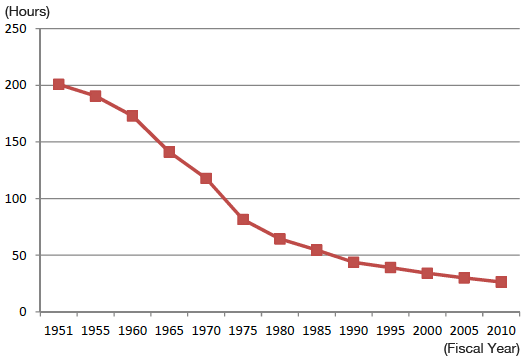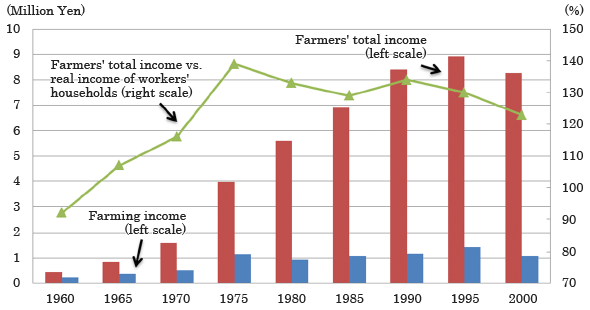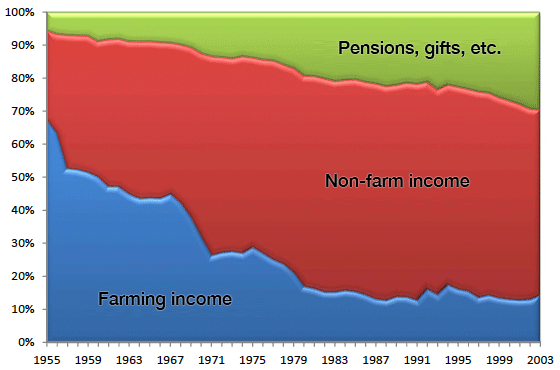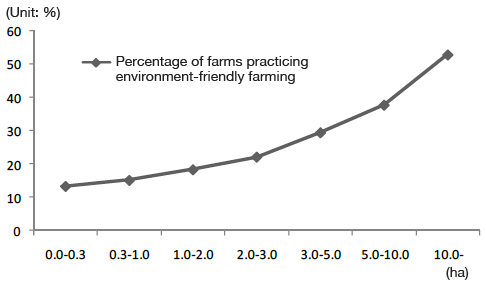Whenever the government and ruling parties try to change agricultural policy, the question of farmers' income inevitably presents a problem. It is never the government's policy to give national funds to raise the income of economically vulnerable persons such as non-regular workers and owners of small and medium-size stores in streets filled with shuttered businesses. Farmers alone, on the other hand, including part-timers who work office or factory jobs during the week and only farm on the weekends, are given money raised by taxes to ensure that they have enough income. Now, the government and ruling parties are discussing changes to Japan's acreage reduction policies. This debate too has raised the question of what will happen to farmers' income and what specifically can be done to raise it. There are systems in place to provide welfare benefits to the needy. Isn't this enough? Why are farmers alone a special case?
The Ministry of Agriculture, Forestry, and Fisheries has estimated that farming income would rise by 13% in the average farming community as a result of the policy changes under discussion. That is because there would be a big increase in subsidies for growing rice as animal feed rather than a staple food, and a new mechanism would be put in place to subsidize farmers who take steps to maintain agricultural land. Of course, the estimate assumes that rice prices will not fall.
The question of how farmers' income in their own voting districts will change as a result of policy changes is a very important one to politicians as implementing any policy that displeases farmers could make politicians lose their next election.
During a recent election, the farming group Japan Agricultural Cooperatives (JA) held a major campaign in opposition to the Trans-Pacific Partnership (TPP). Diet members from rural areas won their races by promising that the JA will oppose the TPP and the elimination of agricultural tariffs. Why do farmers and the JA have increasing political clout when agriculture is in decline and the number of farmers is shrinking? The critical point is the change of the election system. In a system of one representative from one voting district wherein two major candidates are vying for office, a 1% shift of the vote to one candidate creates a gap of two percentage points between them. Making up this gap is not easy. A member of the House of Representatives once told me, "At election time, I really have a 'murderous intent' toward my opponent." He probably was speaking quite frankly. The farm vote no longer has the power to ensure that one candidate will win. However, in our election system, they have plenty of power to ensure that a candidate loses. Even if it is just 1% of the total electorate, farmers are a block vote that candidates cannot afford to lose. In rural areas, the farm vote is about 5%. Nothing is more frightening to a candidate than the vote of organized pressure groups.
The present policy changes happened because the Liberal Democratic Party (LDP) campaigned on a promise to eliminate the policy of providing income compensation to farmers on a household basis that was implemented by the Democratic Party of Japan (DPJ) administration in FY2010, a program which the LDP criticized as a handout. Under the DPJ's program, household-based income compensation is paid to farmers who meet acreage reduction targets. Therefore, the media have equated the elimination of household-based income compensation to the elimination of the acreage reduction policy. But revising the acreage reduction policy was never an issue.
Under the household-based income compensation program, farmers are paid 15,000 yen per 10 ares (Note) of rice paddies (the basis for this being the difference between the market price and the guaranteed price paid to farmers), and if the rice price goes below a certain level, farmers are also paid for the amount that it falls short of that level. This was an absurd policy to compensate the farm income, even for those whose main occupation is an office or factory job, but it was very popular among farmers. As the program name implies, the policy was supposed to compensate farmers' income, so members of the ruling party worried that elimination of the policy would cause farmers' income to shrink and put party politicians at risk in elections.
Consequently, income compensation will be cut in half to 7,500 yen next fiscal year instead of being eliminated immediately. It is scheduled to be eliminated after five years, but in the world of agricultural policy, promises for the future often turn out empty. For example, in 2002, it was decided that allotments of rice production targets (i.e., acreage reduction targets) would stop in 2007. After that rule went into effect in 2007, however, it was repealed immediately. This time, likewise, the LDP campaigned on the promise to eliminate the household-based income compensation to farmers, but it has not happened. And there is no single agricultural group or farmer to blame for breaking that promise.
Why is only farmers' income being taken up? The government always addresses only farmers' income
In China, people living in urban areas have three times the income of those living in rural communities. This is the country's biggest domestic problem. Japan faced a similar one prior to World War II. Rural communities were quite poor compared to the cities. Tenant farmers had to give nearly half of their rice crop to the landowners as rent. The tenants then sold the remaining rice and used the proceeds to support themselves and purchase fertilizer for the following year's crop. Therefore, some tenant farmers could not even eat the rice which they grew. There is even a story that when a person was at the point of death, another would shake a bamboo cylinder filled with rice grains to make a noise by the person's ear and send him on his way to the next world. Particularly during the Showa Depression in 1930, there was an abundant harvest that caused rice prices to crash, followed by a poor crop in Tohoku and Hokkaido in the following year. The disaster got so bad that farmers in Tohoku were selling their daughters into prostitution because of a lack of food.
Officials in the prewar Ministry of Agriculture and Forestry, such as Takekazu Ogura and Masayoshi Ito, witnessed the misery in rural communities and were inspired to try to overcome the poverty found there. Trying to lift up the status of tenant farmers, prewar agricultural officials continually challenged the landowner class and the Imperial Diet politicians who represented its interests. Their tenacious zeal bore fruit in postwar agricultural land reform. History textbooks claim that it was the Supreme Commander for the Allied Powers (SCAP) and the Occupation authorities that implemented agricultural land reform, but that is mistaken. Out of all of the postwar economic reforms such as dissolution of the zaibatsu (family-owned conglomerates), agricultural land reform was the only one proposed by the Japanese government and the Ministry of Agriculture and Forestry. Of course, it took the influence of SCAP to persuade the Conservative Party of the time, which opposed agricultural land reform. However, it was the Ministry of Agriculture and Forestry that proposed and carried it out.
Tenant farmers became small landowners as a result of this reform. The vast profits resulting from conversion of farmland to residential land or public works sites went to farmers. Starting around 1965, forces such as the buildup of new industrial cities created places of employment close to rural communities, promoting part-time farming.
Rice production became more mechanized, greatly reducing the time needed to do farm work. As a result, the average-sized rice paddy could be worked sufficiently on weekends alone. The Chinese character for the word "rice" recalls the number 88, and it used to be said that it takes 88 troubles to grow rice, but that age is past. The era of Oshin, a very popular drama in Asia and set against a background of a Japanese poor farming village, is no more. In 1951, the owner of a standard rice farm (one hectare) would have had to work 251 days a year, eight hours a day. By 2010, the work requirement had shrunk to a mere 30 days, which is why such a remarkable number of rice farmers became part-timers. Even in rural communities, most farmers work office or factory jobs as their main occupation and tend their rice paddies as a side business on the weekends.

Though these are small farmers, they are certainly not poor, because they hold office or factory jobs. The 1961 Agricultural Basic Act listed correcting of the income divide between agriculture and industry as its major objective. Starting in 1965, however, farm income actually surpassed the income of workers' households owing to increasing rice prices and the rise of part-time farming. Poverty has disappeared from the rural communities. Breaking down farmers' income, annual income from farming itself is 1.1 million yen on average. Income from non-farm work (such as the jobs held concurrently with farming) is about four times that, or 4.32 million yen. Another 2.29 million yen comes from pensions and other sources. There are still small farmers in rural communities, but there are no poor farmers. Small farmers are wealthy and farm part time.


Small, part-time farmers cannot put a great deal of time into farming, since they only have the weekends to work their farms. They also practice low-effort farming in other ways, using large amounts of pesticides and chemical fertilizers (e.g., when weeds appear, the farmer simply sprays them). The larger the farm is, the more time the farmer puts into it, and, consequently, the more eco-friendly it is. Fewer than 20% of rice farms of less than one hectare in size practice farming that protects the environment, but more than 50% of farms of 10 hectares or more in size do so (2000).

However, many Japanese citizens live in urban areas and have been detached from farming for a long time. Their knowledge and image of farming and rural communities are based not on any personal experience or association with them. Rather, they have a conceptual and standardized vision of farming and rural communities that they learned from their school education, books, and dramas like Oshin. They have a stereotyped idea that, in rural communities, nearly everyone is a farmer, is poor, and toils in rice cultivation. The image of the industrious prewar farmer, poor and unable to use fertilizer or pesticides, evokes a sense of nostalgia among many Japanese. This inspires sympathy for the small (part-time) farmer. And that is why people want to protect (wealthy) farmers' income.
So is agricultural policy unnecessary?
Even if we assume that farmers' income shouldn't be a problem, it is still essential to maintain and develop agriculture for several reasons. For one, agriculture provides food security, ensuring that the Japanese people have a stable supply of food. Second, it provides a range of benefits other than producing agricultural products, such as cultivating water resources. These functions, however, are for the sake of the Japanese citizens and consumers in general. Prewar agricultural officials never forgot this point for one moment. Kunio Yanagita, the well-known folklore scholar who joined the Ministry of Agriculture and Commerce in 1900, insisted that if Japan thought on behalf of its consumers, instead of raising rice prices and guaranteeing farmers' income, the nation should import rice and cause prices to fall.
Tadaatsu Ishiguro, who served two terms as Minister of Agriculture and Commerce and is emblematic of the prewar agricultural bureaucracy, said, "Agriculture should be the foundation of the nation. Agriculture that is not the foundation of the nation is not worth mentioning." For Ishiguro, agriculture as the foundation of the nation meant that it fulfills an obligation to provide a stable supply of food to the people.
However, the government continues to adopt policies like acreage reduction that keep rice prices high. These reduce the agricultural land resource essential to food security and do not allow paddy fields to provide their full range of multiple functions. Why is that? Food security and multi-functionality are great ideas, but no policy was ever derived from them, not even once. These keywords have only been invoked as postscript reasons to explain given policies.
What Kunio Yanagita and his successors in the mainstream of agricultural policy despised more than anything were policies like acreage reduction that reduced rice production and drove up rice prices for the Japanese consumers. Agricultural policy must never forget that the starting point of economic policy is to govern the nation while providing relief to people.
The original text in Japanese was posted on December 26, 2013.
March 17, 2014


